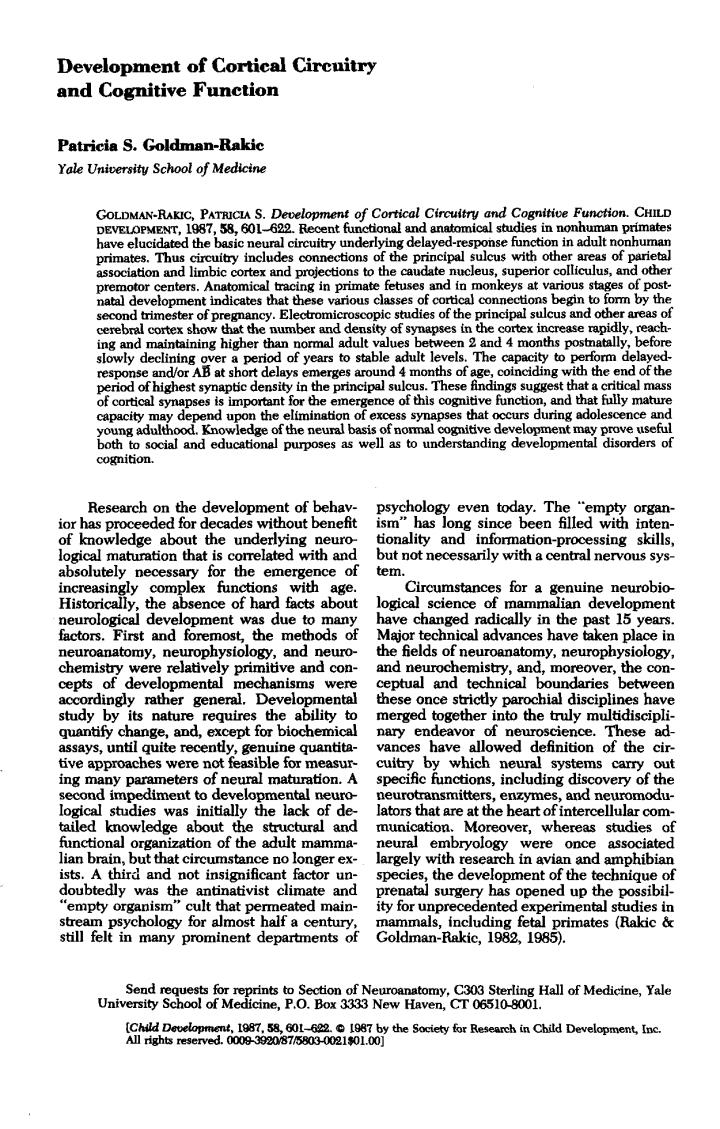正在加载图片...

Development of Cortical Circuitry and Cognitive Function Patricia S.Goldman-Rakic y include of s to th keys at vario esterod studies city t e end gs sugge nd that fully Pmcheeogenogpehlcgrtaten about t the un derlying neur 3 not neces absolutely nec the eme 1oegicalrgcientence. euroanatomy,n ophysiolog and neuro ny,neurophysiology study by its the ability to ept for biocher tive approaches w which ms carr iment to 5 euro nsmitt and ne led kn t ural and whe but that ci the ac t mamma eural ryology onc and not insigni the deve pment of the empty or cult that ed moin ity for unpre erime hudiestg still felt in many prominent departments of Goldman-Rakic.19821965). Uahn8em58aP8aeasHwofModctae,Yad heteCldDvlomencDevelopment of Cortical Circuitry and Cognitive Function Patricia S. Goldman-Rakic Yale Unit>ersity School of Medicine GOLDMAN-RAHC, PATMCIA S. Development of Cortical Circuitry and Cognitive Function. GHILD DEVEIJOPMENT, 1987,58,601-622. Recent fiinctionai and anatomical studies in nonhuman primates have elucidated the basic neural circuitry underlying delayed-respohse function in adult nonhuman primates. Thus circuitry includes connections of the principal sulcus with other areas of parietal association and limbic cortex and projections to the caudate nucleus, superior colliculus, and other premotor centers. Anatomical tracing in primate fetuses and in monkeys at various stages of postnatal development indicates tfiat these various classes of cortical connections begin to form by tiie second trimester of pregnancy. Electromicroscopic studies of the principal sulcus and odier areas of cerebral cortex show that the number and density of synapses in die cortex increase rapidly, reaching and maintaining higher tiian normal adult values between 2 and 4 montfis postnatally, before slowly declining over a period of years to stable adult levels. The capacity to perfonn delayedresponse and/or AB at short delays emerges around 4 months of age, coinciding with the end of the period of highest synaptic density in the principal suleus. These findings suggest that a critical mass of cortical synapses is important for die emergence of this cognitive function, and that fully mature capacity may depend upon the elimination of excess synapses that occurs during adolescence and young adulthood. Knowledge of the neural basis of nonnal cognitive development may prove useful both to social and educational purposes as well as to understanding developmental disorders of cognition. Research on the development of behavior has proceeded for decades without benefit of knowledge about the underlying neurological maturation that is correlated with and absolutely necessary for the emergence of increasingly complex functions with age. Historically, &e absence of hard facts about neurological development was due to many factors. First and foremost, the methods of neuroanatomy, neurophysiology, and neurochemistry were relatively primitive and concepts of developmental mechanisms were accordingly rather general. Developmental study by its nature requires the ability to quantify change, and, except for biochemical assays, until quite recently, genuine quantitative approaches were not feasible for measuring many parameters of neural maturation. A second impediment to developmental neurological studies was initially the lack of detailed knowledge about the structural and functional organization of the adult mammalian brain, but that circumstance no longer exists. A third and not insignificant fector undoubtedly was the antinativist climate and "empty organism" cult that permeated mainstream psychology for almost half a century, still felt in many prominent departments of psychology even today. The "empty organism" has long since been filled wilii intentionality and information-processing skills, but not necessarily with a central nervous system. Circumstances for a genuine neurobiological science of mammalian development have changed radically in the past 15 years. Mfgor technical advances have taken place in the fields of neuroanatomy, neurophysiology, and neurochemistry, and, moreover, the conceptual and technical boundaries between diese once strictly parochial disciplines have merged together into the truly multidisciplinary endeavor of neuroscience. These advances have allowed definition of the circuitry by which neural systems carry out specific functions, including discovery of the neurotransmitters, enzymes, and neuromoduIators that are at the heart of intercellular communication. Moreover, whereas studies of neural embryology were once associated largely with research in avian and amphibian species, the development of the technique of prenatal surgery has opened up the possibility for unprecedented experimental studies in mammals, including fetal primates (Raldc 6c Goldman-Rakic, 1982, 1985). Send request for reprints to Section of Neuroanatomy, C303 Sterling Hall of Medicine, Yale University School of Medicine, P.O. Box 3333 New Haven, CT 06510-8001. IChM Developmeat, 1987,58,601-622. O 1987 by the Society for R€ssearch in Ghild Development, Inc. All rights reserved. 000&O920/87/5803-0021*01.00]